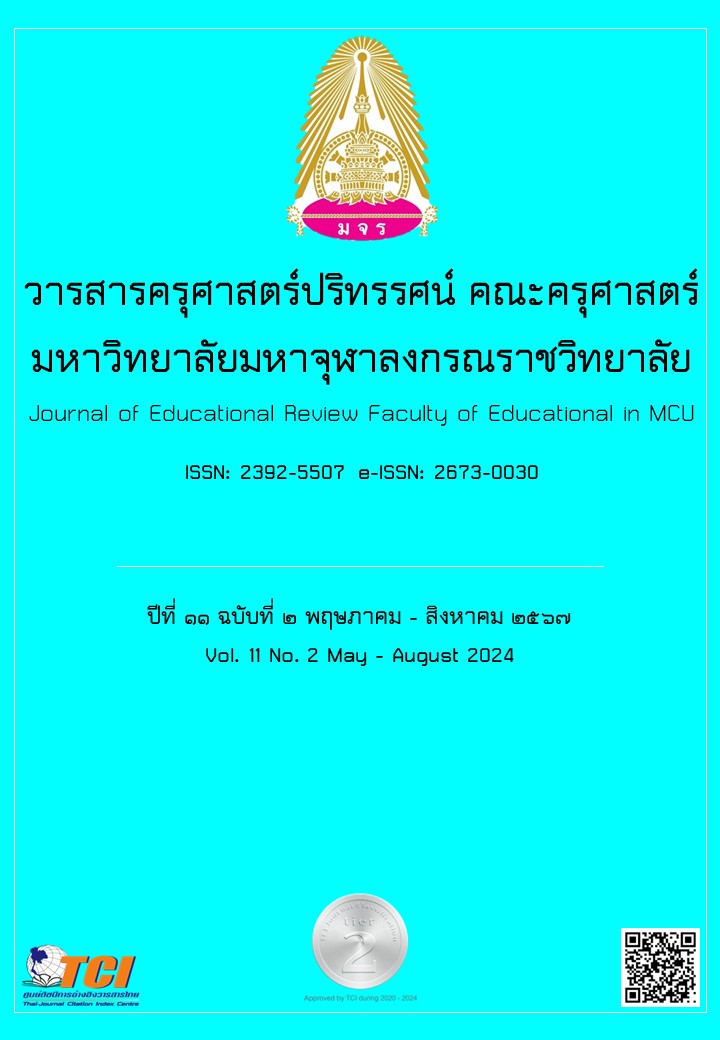TEACHER HAPPINESS: THE KEY TO THE SUCCESS OF EDUCATION MANAGEMENT
Main Article Content
Abstract
Studying teachers' happiness was an important part of advancing educational reform according to the specified goals. Teachers' happiness affected students' positive emotions and learning motivation. Happy teachers were therefore a predictor of students' happiness and learning performance. Happiness occurred when a person experiences positive emotions from a situation that the person interpreted as desirable. Factors related to teachers' happiness at work were classified as personal factors such as age, education, skills, and work experience, and environmental factors such as working atmosphere, colleagues, leaders, salary, students' responsibilities, and progress. These factors affected teachers' job satisfaction, creating happiness in teachers' work was therefore an effort to respond to teachers' physical and mental needs in a correct, appropriate, and balanced manner, understanding each teacher's nature, and thoroughly understanding teachers' work conditions to make teachers happy and be the driver of educational management toward the success of students and educational institutions which developed human resources for economic growth, peace, equality, and sustainability of the nation.
Article Details

This work is licensed under a Creative Commons Attribution-NonCommercial-NoDerivatives 4.0 International License.
ทัศนะและความคิดเห็นที่ปรากฏในบทความในวารสารฉบับนี้ถือเป็นความรับผิดชอบของผู้เขียนบทความนั้นเพียงผู้เดียว และไม่ถือเป็นทัศนะและความรับผิดชอบของกองบรรณาธิการ
กองบรรณาธิการขอสงวนสิทธิ์ในการคัดเลือกบทความลงตีพิมพ์และจะแจ้งให้เจ้าของบทความทราบหลังจากผู้ประเมินบทความตรวจอ่านบทความแล้ว
ต้นฉบับที่ได้รับการตีพิมพ์ในวารสารครุศาสตร์ปริทรรศน์ คณะครุศาสตร์ มหาวิทยาลัยมหาจุฬาลงกรณราชวิทยาลัย ถือเป็นกรรมสิทธิ์ของคณะครุศาสตร์ มหาวิทยาลัยมหาจุฬาลงกรณราชวิทยาลัย ห้ามนำข้อความทั้งหมดหรือบางส่วนไปพิมพ์ซ้ำ เว้นเสียแต่ว่าจะได้รับอนุญาตจากมหาวิทยาลัยฯ เป็นลายลักษณ์อักษร
References
คัคนางค์ มณีศรี และวัชราภรณ์ บุญญศิริวัฒน์. (2545). ความสุขคืออะไร?. แหล่งที่มา https://www.psy.chula.ac.th/th/feature-articles/what-is-happiness สืบค้นเมื่อ 2 มิ.ย. 2566.
ฉัฐวีณ์ ฉายสุวรรณ์. (2564). ปัจจัยที่มีความสัมพันธ์ต่อความสุขในการทำงานของพนักงานองค์การบริหารส่วนตำบลเขาคันทรง.อำเภอศรีราชา จังหวัดชลบุรี. วิทยานิพนธ์รัฐประศาสนศาสตรมหาบัณฑิต. วิทยาลัยการบริหารรัฐกิจ มหาวิทยาลัยบูรพา.
ชยากานต์ เปี่ยมถาวรพจน์ . (2559). ปัจจัยที่ส่งผลต่อความสุขในการทำงานของครูสถานศึกษามัธยมศึกษาจังหวัดฉะเชิงเทรา สังกัดสำนักงานเขตพื้นที่การศึกษามัธยมศึกษา เขต 6. วิทยานิพนธ์การศึกษามหาบัณฑิต. มหาวิทยาลัยบูรพา.
ธร สุนทรายุทธ. (2556). ทฤษฎีองค์กรและพฤติกรรม : หลักการทฤษฎีการวิจัยและปฏิบัติทางการศึกษา. กรุงเทพมหานคร: เนติกุลการพิมพ์.
พจนรินทร์ เหลืองอรัญนภา. (2556). ทักษะการบริหารของผู้บริหารสถานศึกษาที่ส่งผลต่อความสุขในการทำงานของครูสังกัดสำนักงานเขตพื้นที่การศึกษามัธยมศึกษา เขต 8. วิทยานิพนธ์การศึกษามหาบัณฑิต. มหาวิทยาลัยศิลปากร.
พระครูปลัดสัมพิพัฒนศีลาจารย์ (ครรชิต คุณวโร). (2566). ระดับความสุขในชีวิต. แหล่งที่มา https://gened2.cmru.ac.th/ge_learning/src/gen1403/GEN1403-C3.pdf สืบค้นเมื่อ 27 มิ.ย. 2566.
พระพรหมคุณาภรณ์ (ป. อ. ปยุตโต). (2555). พุทธธรรม ฉบับปรับขยาย - พุทธธรรมประดิษฐาน 26 ศตวรรษกาล. พิมพ์ครั้งที่ 32. กรุงเทพมหานคร: ผลิธัมม์.
ภูริชญา ยิ้มแย้ม. (2556). โมเดลความสัมพันธ์เชิงสาเหตุของความสุขในการทำงานของครูสถานศึกษาเทศบาล สังกัดองค์กรปกครองส่วนท้องถิ่น. ดุษฎีนิพนธ์การศึกษาดุษฎีบัณฑิต. มหาวิทยาลัยบูรพา.
วรรณวัฏ ณ พัทลุง และสุดาพร ทองสวัสดิ์. (2565). องค์กรแห่งความสุขของสถานศึกษาขนาดใหญ่พิเศษ สังกัดสำนักงานเขตพื้นที่การศึกษามัธยมศึกษาสงขลา สตูล. การประชุมหาดใหญ่วิชาการระดับชาติและนานาชาติ ครั้งที่ 13 มหาวิทยาลัยหาดใหญ่.
สถาพร พฤฑฒิกุล. (2557). ปัจจัยพหุระดับที่ส่งผลต่อความสุขในการทำงานของครูสถานศึกษา มัธยมศึกษาสังกัดสำนักงานคณะกรรมการการศึกษาขั้นพื้นฐานภาคตะวันออก. วารสารวิชาการ ศรีปทุมชลบุรี. 11(4). 60-70.
สำนักงานกองทุนสนับสนุนการสร้างเสริมสุขภาพ. (2562). ความสุข 8 ประการ (Happy 8). แหล่งที่มา https://resourcecenter.thaihealth.or.th/media/5RMx สืบค้นเมื่อ 2 มิ.ย. 2566.
สุมาลี ทองดี. (2563). ปัจจัยที่ส่งผลต่อความสุขในการทำงานของบุคลากร คณะมนุษยศาสตร์และสังคมศาสตร์มหาวิทยาลัยทักษิณ. วารสารวิชาการ ปขมท. 9(1). 141 – 155.
สุรัตพิมพ์ ถ้ำทอง. (2554). ความสุขในการทำงานของครูระดับประถมศึกษาสังกัดสำนักงาน เขตพื้นที่การศึกษาประถมศึกษาลำปาง เขต 3. วิทยานิพนธ์บริหารธุรกิจมหาบัณฑิต. มหาวิทยาลัยเชียงใหม่.
สุริยัญ ชูช่วย. (2545). การแสวงหาความสุขและคุณค่าของชีวิต กรณีศึกษาทัศนะกลุ่มคนต่างวัยในกรุงเทพมหานคร. วิทยานิพนธ์ศิลปศาสตรมหาบัณฑิต. มหาวิทยาลัยมหิดล.
Aziz, R., Mangestuti, R. & Wahyuni, E. (2018). What Makes the Teacher Happy?. In Proceedings of the 1st International Conference on RecentInnovations. ICRI. 1458-1463. DOI: 10.5220/0009929614581463.
Bishay, A. (1996). Teacher motivation and job satisfaction: A study employing the experience sampling method. Journal of Undergraduate Sciences. 3(3). 147–155.
Bota, O. A. (2013). Job Satisfaction of Teachers. Procedia - Social and Behavioral Sciences. 83. 634–638. https://doi.org/10.1016/j.sbspro.2013.06.120.
Chui, W. H. & Wong, M. Y. H. (2016). Gender Differences in Happiness and Life Satisfaction Among Adolescents in Hong Kong: Relationships and Self Concept. Social Indicators Research. 125(3). 1035–1051. https://doi.org/10.1007/s11205-015-0867-z
Clark, A. E. (1997). Job satisfaction and gender: Why are women so happy at work?. Labour Economics. 4(4). 341–372. https://doi.org/10.1016/S0927- 5371(97)00010-9.
Cynthia D. Fisher. (2010). Happiness at Work. International Journal of Management Reviews. 12. 384–412 DOI: 10.1111/j.1468-2370.2009.00270.x.
Demirel, H. (2014). An Investigation of the Relationship between Job and Life Satisfaction among Teachers. Procedia - Social and Behavioral Sciences. 116. 4925-4931. https://doi.org/10.1016/j.sbspro.2014.01.1051.
Dou, D., Devos, G. & Valcke, M. (2017). The relationships between school autonomy gap, principal leadership, teachers' job satisfaction, and organizational commitment. Educational Management Administration & Leadership. 45(6). 959–977.
Duckworth, A. L., Quinn, P. D. & Seligman, M. E. (2009). Positive predictors of teacher effectiveness. The Journal of Positive Psychology. 4(6). 540–547.
Feldman, F. (2008). Whole Life Satisfaction Concepts of Happiness: whole life satisfaction concepts of happiness. Theoria. 74(3). 219–238. https://doi.org/10.1111/j.1755-2567.2008.00019.x.
Fowler, J.H. & Christakis, N.A. (2008). Dynamic spread of happiness in a large social network: longitudinal analysis over 20 years in the Framingham Heart Study. British Medical Journal. 337. 23–27.
Glatzer, W. (2000). Happiness: Classic theory in the light of current research. Journal Happiness Studies. 1(4). 501-511.
Hatfield, E., Cacioppo, J.T. & Rapson, R.L. (1994). Emotional Contagion. Cambridge: Cambridge University Press.
Herzberg, F. (1968). Work and the nature of man. New York: World.
Hori, M. & Kamo, Y. (2017). Gender Differences in Happiness: The Effects of Marriage, Social Roles, and Social Support. In East Asia. Applied Research in Quality of Life. https://doi.org/10.1007/s11482-017- 9559-y.
Lyubomirsky, S. & Ross, L. (1997). Hedonic consequences of social comparison: a contrast of happy and unhappy people. Journal of Personality and Social Psychology. 73. 1141–1157.
Lyubomirsky, S. (2001). Why are some people happier than others? The role of cognitive and motivational processes in well-being. American Psychologist. 56(3). 239.
Manion, J. (2004). Joy at work: Creating a positive workplace. JONA The Journal of Nursing Administration. 33(12). 652-659.
Maslow, A. (1970). Motivation and personality. New York: Harper and Row.
Owen, R. G. & Steinhoff, C. R. (1989). Towards a theory of organizational culture. Journal of Educational Administration. 27(3). 6-19.
Petterson. J., Purkey, S. & Parker, J. (1986). Guiding beliefs of our school district, productive school system for nonrational world. Artington, VA: Association for Supervision and Curriculum Development.
Reis, H.T., Sheldon, K.M., Gable, S.L., Roscoe, J. & Ryan, R.M. (2000). Daily well-being: the role of autonomy, competence, and relatedness. Personality and Social Psychology Bulletin. 26. 419–435.
Şahin, F. T. & Sak, R. (2016). A Comparative Study of Male and Female Early Childhood Teachers’ Job Satisfaction in Turkey. Early Childhood Education Journal. 44(5). 473–481. https://doi.org/10.1007/s10643-015-0738-x.
Sheldon, K.M., Ryan, R. & Reis, H.T. (1996). What makes for a good day? Competence and autonomy in the day and in the person. Personality and Social Psychology Bulletin. 22. 1270–1279.
Tadić, M., Bakker, A. B. & Oerlemans, W. G. M. (2013). Work happiness among teachers: A day reconstruction study on the role of self-concordance. Journal of School Psychology. 51(6). 735–750. https://doi.org/10.1016/j.jsp.2013.07.002.
Warr, P. (1990). The measurement of well-being and other aspects of mental health. Journal of Occupation Psychology. 62. 193-210.
World Health Organization. (2010). Healthy workplaces: a model for action: for employers, workers, policymakers and practitioners. WHO Press. Switzerland.

